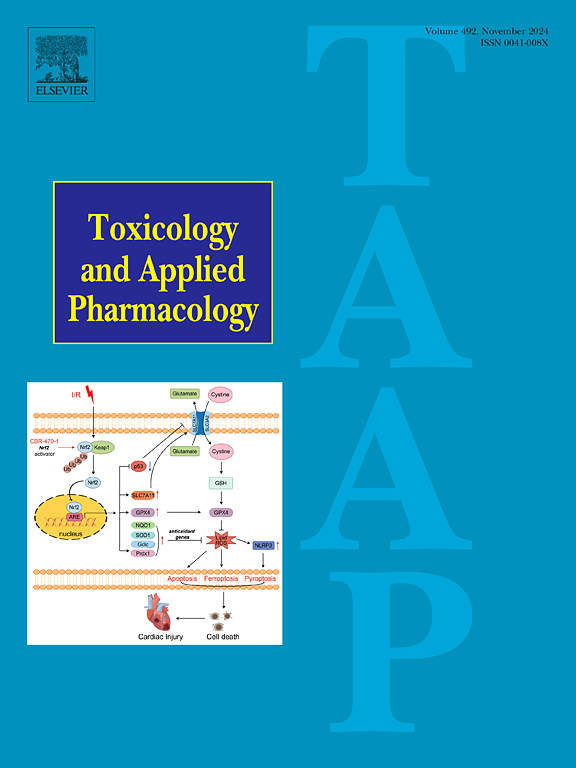Metabolomic and molecular analysis reveals multiple pathways of TBBPA-induced developmental toxicity in zebrafish embryos
IF 3.3
3区 医学
Q2 PHARMACOLOGY & PHARMACY
引用次数: 0
Abstract
Tetrabromobisphenol A (TBBPA), a commonly utilized flame retardant, presents potential risks to both environmental and human health, with particular concern regarding its impact on embryonic development.This study employed zebrafish embryos as a model organism to investigate the comprehensive toxicological effects of TBBPA exposure, integrating metabolomics analysis with molecular and biochemical approaches. Embryos exposed to TBBPA concentrations ranging from 0.5 to 1.5 mg/L exhibited significant dose-dependent developmental abnormalities, including pericardial edema, yolk sac enlargement, and body axis curvature. At 96 h, we observed 50 % mortality at 1 mg/L. At 144 h of exposure to 0.1 mg/L TBBPA, automated behavioral analysis revealed significant changes in larval swimming patterns, characterized by reduced total distance moved, shortened active swimming time, impaired acceleration parameters, and abnormal spatial distribution. UHPLC-Q-TOF-MS-based metabolomics analysis revealed substantial perturbations in multiple biochemical pathways, particularly affecting neurotransmitter metabolism, energy homeostasis, and oxidative stress responses. TBBPA exposure significantly disrupted dopamine and serotonin metabolism, evidenced by altered enzyme expression and metabolite levels. Notable changes in oxidative stress markers, including GSH, MDA, and SOD, indicated significant cellular damage, while inflammatory responses showed dysregulation of both pro- and anti-inflammatory cytokines. Energy metabolism was comprehensively affected, with disruptions in glycolysis, TCA cycle, and amino acid metabolism pathways. The study identified key metabolic signatures of TBBPA toxicity and elucidated the interconnected mechanisms underlying its developmental impacts, providing valuable insights for environmental risk assessment and regulatory considerations. These findings emphasize the complex nature of TBBPA toxicity and highlight the need for careful evaluation of its environmental impact, particularly concerning early developmental exposure.

代谢组学和分子分析揭示了tbbpa诱导斑马鱼胚胎发育毒性的多种途径
四溴双酚A (TBBPA)是一种常用的阻燃剂,对环境和人类健康都有潜在风险,尤其值得关注的是它对胚胎发育的影响。本研究以斑马鱼胚胎为模型生物,将代谢组学分析与分子生化方法相结合,研究TBBPA暴露的综合毒理学效应。暴露于TBBPA浓度在0.5 - 1.5 mg/L范围内的胚胎表现出明显的剂量依赖性发育异常,包括心包水肿、卵黄囊增大和体轴弯曲。在96 h时,我们观察到1 mg/L的死亡率为50%。在暴露于0.1 mg/L TBBPA 14h时,自动行为分析显示,幼虫的游动模式发生了显著变化,表现为总移动距离减少,主动游动时间缩短,加速参数受损,空间分布异常。基于uhplc - q - tof - ms的代谢组学分析揭示了多种生化途径的实质性扰动,特别是影响神经递质代谢、能量稳态和氧化应激反应。TBBPA暴露会显著破坏多巴胺和血清素代谢,这可以通过改变酶表达和代谢物水平来证明。氧化应激标志物(包括GSH、MDA和SOD)的显著变化表明细胞损伤显著,而炎症反应显示促炎性和抗炎性细胞因子的失调。能量代谢受到全面影响,糖酵解、TCA循环和氨基酸代谢途径受到干扰。该研究确定了TBBPA毒性的关键代谢特征,并阐明了其发育影响的相互关联机制,为环境风险评估和监管考虑提供了有价值的见解。这些发现强调了TBBPA毒性的复杂性,并强调了仔细评估其环境影响的必要性,特别是在早期发育暴露方面。
本文章由计算机程序翻译,如有差异,请以英文原文为准。
求助全文
约1分钟内获得全文
求助全文
来源期刊
CiteScore
6.80
自引率
2.60%
发文量
309
审稿时长
32 days
期刊介绍:
Toxicology and Applied Pharmacology publishes original scientific research of relevance to animals or humans pertaining to the action of chemicals, drugs, or chemically-defined natural products.
Regular articles address mechanistic approaches to physiological, pharmacologic, biochemical, cellular, or molecular understanding of toxicologic/pathologic lesions and to methods used to describe these responses. Safety Science articles address outstanding state-of-the-art preclinical and human translational characterization of drug and chemical safety employing cutting-edge science. Highly significant Regulatory Safety Science articles will also be considered in this category. Papers concerned with alternatives to the use of experimental animals are encouraged.
Short articles report on high impact studies of broad interest to readers of TAAP that would benefit from rapid publication. These articles should contain no more than a combined total of four figures and tables. Authors should include in their cover letter the justification for consideration of their manuscript as a short article.

 求助内容:
求助内容: 应助结果提醒方式:
应助结果提醒方式:


